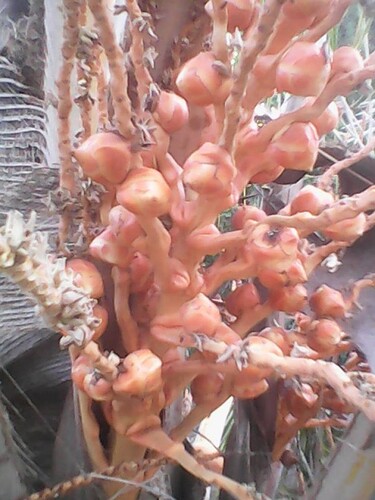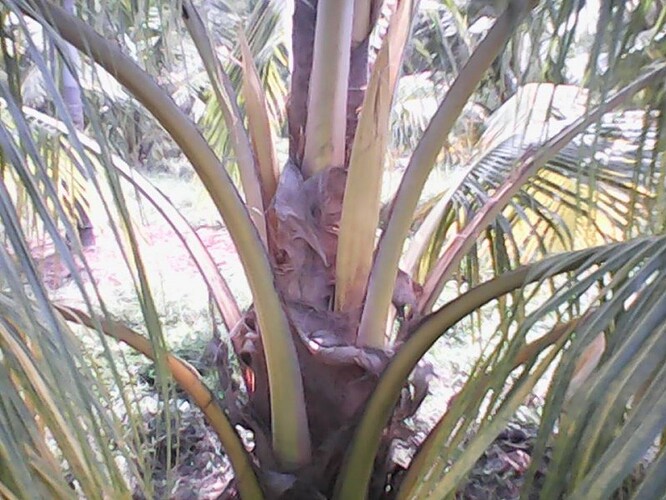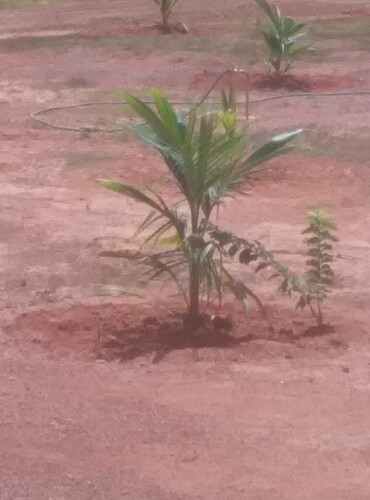AN INSIGHT INTO HYBRID COCONUT PLANTATION AND WAYS TO INCREASE THE YIELD OF FRUITS / NUTS
The lovely plant Coconut ( Cocus nucifera ) belongs to plant family “ Arecaceae” and being in use since 5 lac years .
In the world 95 % of the coconut are Tall varieties and only 5% are dwarf varieties that are Niu Leha, Village Dwarf ,Malayan or Nias Dwarf …Srilankan Dwarf , Chowghat orange Dwaf ( India )
Almost all of the Tall varieties are cross –pollinator ( out breeder ) and dwarf varieties are imbreeder ( self pollinator ) except Niu Leha that is cross pollinator …
The fruits of dwarf varieties are in different shades of color like green, orange, yellow and brown …
The Tall coconut varieties start producing inflorescence in 4.5 to 9 years after planting ,where as dwarf coconut varieties are producing inflorescence in 2-4 years after planting …
The coconut plant initiate flowering 1.5 to 2 years in advance before it is visible to human eyes after its emergence …
Every month one frond( leaf ) is produced accompanying with one spadix ( flower bunch )
The crown of healthy coconut bears 20 to 35 leaves ( fronds ) and each frond measures 25 to 30 feet long …so we give 30 feet spacing between 2 coconut plants …
The spadix ( spear like sheath approximately 1 M long ) will split and yellowish white inflorescence will emerge …the inflorescence bears so many rachis ( branches ) and 0-3 female flowers will be placed at the base of each rachis and the male flowers that are small will be seen at the top of rachis …so the button like female flowers will be seen at the bottom of the inflorescence and tiny male flowers at the top of the inflorescence…
HOW CROSS POLLINATION IS EFFECTED AND WHY YIELD IS LOWER IN INDIA ?
Immediately after opening of sheath ( spadix that covers inflorescence ) the male flowers only at the top most start producing and shedding pollen ( male part of flowers necessary for fertilization ) and other male flowers below produce pollen successively downward and this continues ( downward from top to bottom ) shedding pollen for over 3 weeks …
Only after all the pollen grain is produced and lost , the female flowers will become mature and receptive …so the male flowers could not fertilize the female flowers in the same inflorescence…Hence out breeding and outsourcing of pollen from other coconut plants are needed
Here to assist out breeding ( cross pollination ) the plant needs assistance of winds and insects mainly Bees …the wind helps only to the certain extent say 10-20% and most of the cross pollination is effected by bees …
Generally every inflorescence produce 40 to 60 female flowers in 13 to 17 spadix in a coconut tree but mostly one third of female flowers sets in fruits ie.,13 to 20 in each bunch . In one year it produce 12 bunches @ one bunch per month…The expected yield of nuts per tree per year is 12 * 13 = 160 nuts / 12*20=240 nuts
In case of Dwarf varieties that is predominantly self pollinated ( imbreeding ) …the female and male flowers mature simultaneously ( 90 % self pollination ) and inflorescence produce more flowers say 60 to 120 and also more numbers of spadix per year…The dwarf coconut varieties produces more leaves ( fronds ) and bunches in rapid succession that even the pollen produced in the successive bunches can fertilize the female flowers in the lower bunches in the same coconut tree …This is the reason why the dwarf coconut variety produces more nuts / fruits per tree per year …40 fruits per bunch …for 17 bunches ( dwarf under ideal condition produce more bunches and more leaves ) in a year it is 40 * 17=680 fruits / nuts per tree…Even it produces 1000 fruits / nuts although the size of the fruits are medium to small depending on the number of fruits per tree…
In General the average yield of Tall coconut in India is 60 fruits / nuts per tree per year and it is in the range of 80 to 100 in some states and individual tree yield is noticed upto 240 fruits / nuts per year …
Hybrid gives more yield ?
Dwarf Vs Tall hybrid can be resorted to increase the single tree yield …
When Dwarf coconut is bred with fertile and well performing Tall coconut the resulting hybrid possess characters of both the parents …
1.Earliness say 2 – 4 years flowering unlike 5 to 9 years waiting period in Pure tall varieties
2.More kernel and copra and oil content that is the characters acquired from well performing Tall coconut varieties
3.More number of bunches and fruits per tree per year that is the characters acquired from dwarf varieties …
4.Life period of coconut tree 40 to 50 years that is acquired from Tall coconut tree that lives upto 100 years …whereas Pure dwarf varieties have only 25 to 30 years only …
5.Hybrid can have 40 to 60 % self pollination that enhance individual tree yield upto 350 to 700 numbers
6.The hybrid can tolerate or resist disease and drought that are mostly the characters acquired by tall tree growing in specific location and this characters can well be built up in new hybrids …
Besides the above , other factors also control yield of the coconut tree like
1.Temprature -21- 27 degree Celsius ideal but even grows well in temperature 25 to 36 but certainly temperature beyond 37 degree Celsius will have its negative impact on yield and also cool season with temperature below 21 degree Celsius affect yield …
2.Humidity
3.Wind speed
4.Disease and pest –
a) In the recent past one serious pest called Eriophyte mite devastated entire coconut plantation
b) Black headed caterpillar ( BHC ) that skeletanize the leaves by eating all the chlorophylls ( green part ) and makes coconut plants looks dry and withered canopy
c) Corid bugs that eats new female buttons that fall down
d) Rhinocerous beetles that cut tender leaves ( Zero leaves exactly at the growing point inside the crown of the growing coconut plants )
e) Stem weevil that feeds on the trunk making holes and splits that oozes gumming liquid
f) Bud rot disease killing plant soon
g) yellowing disease ( kind of mycoplasma ) that infect coconuts and is noticed and visible when the plants are totally sick and about to loose vigour and finally die
g) Nutrients – Major nutrients like Nitrogen, Phospohrus , Potash ( Kcl ) – Secondary nutrients like Calcium ( roots and crown development ) , Manesium ( fronds growth and development ) Sulphur ( the deficiency of sulphur will choke the crown and new leaves will not come out quickly and leaflets will not split away in the fronds )
And most essentially micro nutrients like Boron ( the deficiency of which make the female flowers that produce fruits/ nuts fall down easily by cutting and closing the root canal supplying water and nutrients from mother trunk to newly formed and fertilized female flowers and also poor kernel setting and oil …
Next Zinc, Copper ( the deficiency of which reduce fronds growth and development that looks bluish yellow and wavy )
Molybdenum and chlorine also most important in coconut plant physiology …
Last but not the least , the altitude – The coconut can grow upto 1000 MSL above the limit it grows but does not produce yield …Because every 100 meters increase in altitude the temperatures goes down by 0.6 degree Celsius …If plain land temperature is 27 degree Celsius , the temperature at an altitude 1000 MSL will be 21 degree Celsius below which the yield of coconut will be less or nil …
HOW TO IDENTIFY THE HYBRIDS
Generally female coconut tree used in breeding is dwarf coconut that looks orange, yellow that are controlled by recessive genes in homozygous condition ( rr is excessiveness and RR denoted as dominant ) …when the dwarf coconut variety is bred with Tall coconut variety that generally looks green everywhere , the resulting hybrid will not show either orange or yellow color because the color will be disguished by dominant gene from Tall tree ( Rr genes ) …Hence the Hybrid seedlings from the nursery can be selected by noting the color , stoutness of the crown , early splitting of leaflets and girth of seedlings that are significantly well formed and robust .Such a hybrid only can produce more yield per tree per year …
AVOID SPURIOUS COCONUT SEEDLINGS
Some nursery are selling spurious coconut seedlings …These days men power has become costly and trained labor was not available …so the dwarf coconut trees are planted among the tall coconut trees and are allowed natural cross pollination through winds and insects …Most of the cases , not all the nuts are fertilized and nuts collected are sown in nursery and sold as hybrid…So the it needs utmost care while selecting hybrid coconut seedlings …
OTHER HYBRIDS
Tall Vs Dwarf
Tall Vs Tall
PURPOSE OF BREEDING
1.To increase number of fruits per tree per year
2.To increase kernel/ oil content
3.To instill the characters like disease and drought tolerance and resistance etc…



